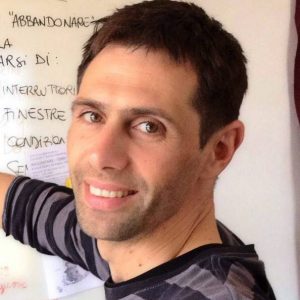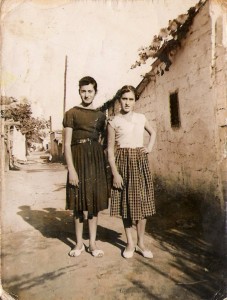Check also his personal webpage
Stefano Portelli (Rome, 1976), independent researcher attached to the Institut Català d’Antropologia, founding member of the Research group of Perifèries Urbanes, administrator of the website https://periferiesurbanes.org, and member of the multidisciplinary collective of anthropologists, architects and town planners Repensar Bonpastor. He graduated in Cultural Anthropology in 2001 from the University of Rome “La Sapienza” with a thesis on the contradictions of international development cooperation based on field work in the periphery of Managua (Nicaragua), valued with the highest note summa cum laude. In Barcelona, it dealt with the social impact of urban transformations and the interaction between collective memory and struggles for the territory, promoting projects subsidised by the ICA and the Memorial Democràtic de Catalunya. Mentrestant treballava com a educador social amb infants i menors no acompanyats, interessant-se en les ideologies del control i en l’autonomia dels nens en l’espai públic.
Starting in 2004 he began field work in the neighborhood of cheap houses of the Bon Pastor, which was being demolished. In collaboration with an association of local residents, and with a coordinating team by Professor Manuel Delgado, the research focused on past and present forms of opposition to the planning and impact of the reconfiguration of the space on the everyday and perceptions of the inhabitants, with special interest in the dynamics of immigration and exclusion, on the techniques of conflict resolution, and the autonomy of children. In 2009 this work was subsidised by l’Inventari del Patrimoni Etnològic de Catalunya, and the resulting monograph “La ciutat horitzontal: lluita social i memòria col·lectiva a les cases barates de Barcelona”, was published in 2015 in Catalan and in Spanish.
In 2007-2008 I attended the training “Ethnopsychiatrie des nouveaux désordres psychosociaux” at the Georges Dévereux Centre of the University of Paris VIII, focusing since then on ethnotechnics for conflict management and psychological problems, in particular the practices of adorcism linked to Sufi brotherhoods: He resided in Larache (Marrecos) during 2009-2010, and is currently investigating the adaptation of these techniques to the context of the diaspora in Europe, and analysing the applications of space anthropology in social and therapeutic intervention.
Publications (check also his personal webpage):
Activist*scholar collaborations in times of crisis, and beyond: Reflections on ‘Urban Activism: Staking Claims in the 21st Century City’
From the Horizontal to the Vertical
Pietro Saitta, Prendere le case
Eviction and displacement from the neighbourhood of Douar Wasti in Casablanca, Morocco
“The Cry of the Excavator. Notes on the social impact of urban renewall”
La ciudad horizontal. Urbanismo y resistencia en un barrio de casas baratas de Barcelona
“The casas baratas of Bon Pastor: a worker’s reservoir on the edges of Barcelona”.
“Sul mito della partecipazione cittadina a Barcellona: dall’urbanismo franchista al ‘modello’ democratico”
“Repensar Bonpastor: una intervención multidisciplinaria independiente en un barrio afectado por la transformación urbanística”
…

 Si per raons urbanístiques i especulatives hi ha barris de la ciutat ón es concentren més extrangers (zoning), obviament a les escoles d'aquestes zones hi haurà més nens i nenes nascuts d'extrangers. És el cas del barri de Torpignattara, a la perifèria est de Roma, ón una escola de primària s'ha trovat al centre d'infinits debats públics, ón abunden paraules com "gueto", "emergència", "alarma", "banlieue". Mentres que els polítics (de dretes i d'esquerres) es diuen preocupats per la "italianitat" de l'escola, les seves mestres estàn realitzant un treball digne de la millor tradició pedagògica italiana, utilitzant la diversitat com a un recurs per a suplir a les retallades i a la decadència de l'escola pública. Fins quan els anomenaràn "extrangers"? Roma està canviant, i mentres que alguns fan servir aquesta transformació per a estimular la guerra entre pobres, d'altres han entès el seu potencial per a superar l'estancament cultural i polític de l'anomenada "societat italiana".
Si per raons urbanístiques i especulatives hi ha barris de la ciutat ón es concentren més extrangers (zoning), obviament a les escoles d'aquestes zones hi haurà més nens i nenes nascuts d'extrangers. És el cas del barri de Torpignattara, a la perifèria est de Roma, ón una escola de primària s'ha trovat al centre d'infinits debats públics, ón abunden paraules com "gueto", "emergència", "alarma", "banlieue". Mentres que els polítics (de dretes i d'esquerres) es diuen preocupats per la "italianitat" de l'escola, les seves mestres estàn realitzant un treball digne de la millor tradició pedagògica italiana, utilitzant la diversitat com a un recurs per a suplir a les retallades i a la decadència de l'escola pública. Fins quan els anomenaràn "extrangers"? Roma està canviant, i mentres que alguns fan servir aquesta transformació per a estimular la guerra entre pobres, d'altres han entès el seu potencial per a superar l'estancament cultural i polític de l'anomenada "societat italiana". 




 “Saps quan va ser la última vegada que vaig pujar al Trebević? Febrer '92. Abans hi anava cada cap de setmana amb el meu pare. No hi vaig tornar mai més. Des d'ahi dalt van caure 22 granades sobre el sostre de casa meva. Ara el miro des de la finestra, i només voldria veure'l desapareixer.”. Bojan, sarajeví de 30 anys.
“Saps quan va ser la última vegada que vaig pujar al Trebević? Febrer '92. Abans hi anava cada cap de setmana amb el meu pare. No hi vaig tornar mai més. Des d'ahi dalt van caure 22 granades sobre el sostre de casa meva. Ara el miro des de la finestra, i només voldria veure'l desapareixer.”. Bojan, sarajeví de 30 anys.